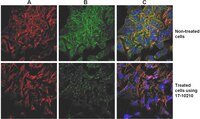ECM532 Sigma-Aldrichα/β Integrin-mediated Cell Adhesion Array Combo Kit, colorimetic
The Alpha/Beta Integrin-Mediated Cell Adhesion Array Kit can be used for assessing the presence or absence of specific integrins on the cell surface.
More>> The Alpha/Beta Integrin-Mediated Cell Adhesion Array Kit can be used for assessing the presence or absence of specific integrins on the cell surface. Less<<Recommended Products
Overview
| Replacement Information |
|---|
Key Specifications Table
| Detection Methods |
|---|
| Chromogenic |
| References |
|---|
| Product Information | |
|---|---|
| Components |
|
| Detection method | Chromogenic |
| Quality Level | MQ100 |
| Physicochemical Information |
|---|
| Dimensions |
|---|
| Materials Information |
|---|
| Toxicological Information |
|---|
| Safety Information according to GHS |
|---|
| Safety Information |
|---|
| Packaging Information | |
|---|---|
| Material Size | 1 plate |
| Material Package | 96 wells |
| Transport Information |
|---|
| Supplemental Information |
|---|
| Specifications |
|---|
| Global Trade Item Number | |
|---|---|
| Catalog Number | GTIN |
| ECM532 | 04053252323928 |
Documentation
α/β Integrin-mediated Cell Adhesion Array Combo Kit, colorimetic SDS
| Title |
|---|
References
| Reference overview | Pub Med ID |
|---|---|
| Effects of amelogenins on angiogenesis-associated processes of endothelial cells. S Almqvist,H K Kleinman,M Werthén,P Thomsen,M S Agren Journal of wound care 20 2011 Show Abstract | 21378680
 |
| Activin A regulates trophoblast cell adhesive properties: implications for implantation failure in women with endometriosis-associated infertility. Chelsea J Stoikos,Lois A Salamonsen,Natalie J Hannan,Anne E O'Connor,Luk Rombauts,Evdokia Dimitriadis Human reproduction (Oxford, England) 25 2010 Show Abstract | 20457668
 |
Technical Info
| Title |
|---|
| Integrin Profiling of Stem Cells and Differentiated Progeny |
| Screening Kits to Monitor Cell - Extracellular Matrix Interactions |
FAQ
| Question | Answer |
|---|---|
| When you say wash gently, what do you mean? How is this different from normal washing? | To wash gently, this is what we would recommend: remove all of the initial solution but 50 microliters. Then, add 250 microliters of wash. With your pipette set at 150 microliters, pipette up and down. Move the plate around and wash all sides of the well to ensure uniformity. Remove the 150 microliters, then add another 150 microliters, repeating this wash step five times. Between washes, you may want to check the test and control wells under the microscope to ensure that you are not washing too vigorously or too gently. When the control wells have about 10% or less cells still attached, read your plate. Of course, washing stringency will depend on the cell type as they differ in their binding capacities, and this should be determined by the researcher. |








